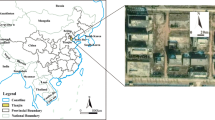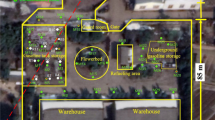Abstract
Groundwater contamination caused by hydrocarbons is a common issue worldwide. Determining the volume of light non-aqueous phase liquids (LNAPL) that contaminate the subsurface environment is crucial for planning effective groundwater and soil remediation strategies, as well as determining the remediation endpoint. However, accurate approaches for quantifying the LNAPL volume in subsurface environments are scarce. To address this gap, we developed and tested a novel approach to quantify the volume of oil phase filling the soil pores. Our approach involves using a high-resolution technique, the laser induced fluorescence (LIF), to identify the presence of the oil phase, which was then correlated to total petroleum hydrocarbons (TPH) quantifications. For that, first, we obtained an empirical model to estimate the TPH present in the soil using fluorescence intensity and then, we converted the fluorescence intensity data in each log to equivalent TPH values. We used the model block approach, commonly used for ore resource estimation, to compute and discretize the volume of the aquifer contaminated by LNAPL into a set of blocks using the LIF data. Each block was assigned a mean TPH mass, which we used as a proxy for the LNAPL mass in the block. By summing the LNAPL mass in all blocks, we estimated the total LNAPL volume/mass in the investigated site. Our approach provides a simple and effective way to determine the amount of LNAPL contaminating the soil and groundwater, offering a new perspective for investigating hydrocarbon-contaminated sites.









Similar content being viewed by others
Data availability
No datasets were generated or analysed during the current study.
References
Alazaiza MY, Ramli MH, Copty NK, Sheng TJ, Aburas MM (2020) LNAPL saturation distribution under the influence of water table fluctuations using simplified image analysis method. Bull Eng Geol Environ 79:1543–1554. https://doi.org/10.1007/s10040-018-1904-1
Aldstadt J, St Germain R, Grundl T, Schweitzer R (2002) An in situ laser-induced fluorescence system for polycylic aromatic hydrocarbon-contaminated sediments. US EPA Report
ARANZ GEO LIMITED. LEAPFROG GEO 4.0 HELP. Available in: http://help.leapfrog3d.com/Geo/4.0/en-GB/Content/intro.htm
Azimi R, Vaezihir A, Lenhard RJ, Hassanizadeh SM (2020) Evaluation of LNAPL behavior in water table inter-fluctuate zone under groundwater drawdown condition. Water 12(9):2337
Boumaiza L, Chesnaux R, Walter J, Lenhard RJ, Hassanizadeh SM, Dokou Z, Alazaiza MY (2022) Predicting vertical LNAPL distribution in the subsurface under the fluctuating water table effect. Groundw Monit Remediat 42(2):47–58
Cavelan A, Golfier F, Colombano S, Davarzani H, Deparis J, Faure P (2022) A critical review of the influence of groundwater level fluctuations and temperature on LNAPL contaminations in the context of climate change. Sci Total Environ 806:150412
Charbeneau RJ (2007) LNAPL distribution and recovery model. Distribution and recovery of petroleum hydrocarbon liquids in porous media, vol 1. API Publication 4760
Chatzis I, Kantzas A, Dullien FAL On the investigation of gravity-assisted inert gas injection using micromodels, long Berea sandstone cores, and computer-assisted tomography. Paper SPE 18284, proceedings of the 1988 63rd annual technical conference and exhibition of the SPE, Houston, TX, October
CL:AIRE (2014) An illustrated handbook of LNAPL transport and fate in the subsurface. Contaminated Land: Applications in Real Environments, London, UK, ISBN 978-1-905046-24-9
Dale S (2021) BP statistical review of world energy. BP Plc: London, UK, pp 14–16
Farr AM, Houghtalen RJ, McWhorter DB (1990) Volume estimation of light nonaqueous phase liquids in porous media. Groundwater 28(1):48–56
Flores G, Katsumi T, Eua-Apiwatch S, Lautua S, Inui T (2016) Migration of different LNAPLs in subsurface under groundwater fluctuating conditions by the simplified image analysis method. J Geoeng Sci 3:15–30. https://doi.org/10.3233/JGS-150033
Frollini E, Petitta M (2018) Free LNAPL volume estimation by pancake model and vertical equilibrium model: comparison of results, limitations, and critical points. Geofluids 2018:1–13
García-Rincón J, Gatsios E, Rayner JL, McLaughlan RG, Davis GB (2020) Laser-induced fluorescence logging as a high-resolution characterisation tool to assess LNAPL mobility. Sci Total Environ 725:138480
Ghosh J, Nag A (2001) An overview of radial basis function networks. In: Radial basis function networks 2: new advances in design. pp 1–36
He Z, Liang F, Meng J, Li N (2022) Effects of groundwater fluctuation on migration characteristics and representative elementary volume of entrapped LNAPL. J Hydrol 610:127833
Isler E, Teramoto EH, Baessa MPM, Pede MAZ, Kiang CH (2018) Trapeamento de LNAPL observado por meio da técnica de fluorescência induzida por laser (LIF). Águas Subterrâneas 32(3):315–324
Karimi Askarani K, Stockwell EB, Piontek KR, Sale TC (2018) Thermal monitoring of natural source zone depletion. Groundw Monit Remediat 38(3):43–52
Krahenbuhl FM, Teramoto EH, Kiang CH (2018) Aplicação do método de fluorescência induzida por laser na caracterização de áreas contaminadas com resíduos oleosos. Águas Subterrâneas 32(1):79–90
Kulkarni PR, Newell CJ, King DC, Molofsky LJ, Garg S (2020) Application of four measurement techniques to understand natural source zone depletion processes at an LNAPL site. Groundw Monit Remediat 40(3):75–88
Lari KS, Johnston CD, Davis GB (2016) Gasoline multiphase and multicomponent partitioning in the vadose zone: dynamics and risk longevity. Vadose Zone J 15(3):1–15
Lari KS, Rayner JL, Davis GB (2018) Towards characterizing LNAPL remediation endpoints. J Environ Manag 224:97–105
Lari KS, Davis GB, Rayner JL, Bastow TP, Puzon GJ (2019) Natural source zone depletion of LNAPL: a critical review supporting modelling approaches. Water Res 157:630–646
Lenhard RJ, Parker JC (1990) Estimation of free hydrocarbon volume from fluid levels in monitoring wells. Groundwater 28(1):57–67
Lu J, Germain RS, Andrews T (2014) NAPL source identification utilizing data from laser induced fluorescence (LIF) screening tools. In: Environmental forensics. pp 77–97
Marinelli F, Durnford DS (1996) LNAPL thickness in monitoring wells considering hysteresis and entrapment. Groundwater 34(3):405–414
McCall W (2010) Tech guide for calculation of estimated hydraulic conductivity (Est. K) Log from HPT Data. Geoprobe System
Ririe GT, Sweeney RE (2022) Rapid field approach to evaluating natural source zone depletion for a range of light non-aqueous phase liquid sites. Groundw Monit Remediat 42(4):67–77
Sale T, Hopkins H, Kirkman A (2018) Managing risk at LNAPL sites—frequently asked questions. American Petroleum Institute Tech Bulletin, p 18
Sihota N, McAlexander B, Lyverse M, Mayer KU (2018) Multi-year CO2 efflux measurements for assessing natural source zone depletion at a large hydrocarbon-impacted site. J Contam Hydrol 219:50–60
Smith JW, Davis GB, DeVaull GE, Garg S, Newell CJ, Rivett MO (2022) Natural source zone depletion (NSZD): from process understanding to effective implementation at LNAPL-impacted sites. Quart J Eng Geol Hydrogeol 55(4):qjegh2021–qjegh2166
Soto MAA, Lenhard R, Chang HK, van Genuchten MT (2019) Determination of specific LNAPL volumes in soils having a multimodal pore-size distribution. J Environ Manag 237:576–584
St. Germain R, Martin T (2008) North American environmental field conference and exposition—LIF workshop slides, Tampa, FL. https://clu-in.org/download/char/lif/Dakota-Technologies-LIF-Workshop.pdf
Steffy DA, Johnston CD, Barry DA (1998) Numerical simulations and long-column tests of LNAPL displacement and trap** by a fluctuating water table. J Soil Contam 7(3):325–356
Suthersan S, Koons B, Schnobrich M (2015) Contemporary management of sites with petroleum LNAPL presence. Groundw Monit Remediat 35:23–29
Teramoto EH, Chang HK (2017) Field data and numerical simulation of btex concentration trends under water table fluctuations: example of a jet fuel-contaminated site in Brazil. J Contam Hydrol 198:37–47. https://doi.org/10.1016/j.jconhyd.2017.01.002
Teramoto EH, Isler E, Polese L, Baessa MPM, Chang HK (2019) LNAPL saturation derived from laser induced fluorescence method. Sci Total Environ 683:762–772
Teramoto EH, Pede MAZ, Chang HK (2020) Impact of water table fluctuations on the seasonal effectiveness of the pump-and-treat remediation in wet–dry tropical regions. Environ Earth Sci 79:1–15
Thornton SF, Tobin K, Smith JW (2013) Comparison of constant and transient-source zones on simulated contaminant plume evolution in groundwater: implications for hydrogeological risk assessment. Groundw Monit Remediat 33(3):78–91
US Environmental PROTECTION AGENCY (2007a) Method 8015C: nonhalogenated organics by gas chromatography. EPA Methods, Washington DC
US Environmental PROTECTION AGENCY (2007b) Method 3550: ultrasonic extraction. EPA Methods, Washington DC
Van Geel PJ, Sykes JF (1997) The importance of fluid entrapment, saturation hysteresis and residual saturations on the distribution of a lighter-than-water non-aqueous phase liquid in a variably saturated sand medium. J Contam Hydrol 25(3–4):249–270
Verginelli I, Baciocchi R (2021) Refinement of the gradient method for the estimation of natural source zone depletion at petroleum contaminated sites. J Contam Hydrol 241:103807
Wagner AM, Barker AJ (2019) Distribution of polycyclic aromatic hydrocarbons (PAHs) from legacy spills at an Alaskan Arctic site underlain by permafrost. Cold Reg Sci Technol 158:154–165
Zimbron JA (2022) Comparison of radiocarbon-and background location-corrections on soil-gas CO2 flux-based NSZD rate measurements at petroleum impacted sites. Groundw Monit Remediat 42(3):116–122
Acknowledgements
The authors extend their sincere appreciation to FUNDUNESP for awarding research grants and to the dedicated employees of Petrobras for their invaluable support in conducting field research activities. The authors express their gratitude to Angelos Almpanis for his meticulous review and insightful observations. His feedback has significantly enhanced the original manuscript.
Author information
Authors and Affiliations
Contributions
The project was conceptualized by H.K.C. The manuscript text was written by M.B. and E.H.T. Field data acquisition was carried out by B.Z.E., M.B., and E.H.T., while data processing was performed by B.P. All authors participated in reviewing the manuscript.
Corresponding author
Ethics declarations
Conflict of interest
The authors declare no competing interests.
Additional information
Publisher's Note
Springer Nature remains neutral with regard to jurisdictional claims in published maps and institutional affiliations.
Rights and permissions
Springer Nature or its licensor (e.g. a society or other partner) holds exclusive rights to this article under a publishing agreement with the author(s) or other rightsholder(s); author self-archiving of the accepted manuscript version of this article is solely governed by the terms of such publishing agreement and applicable law.
About this article
Cite this article
Baessa, M.P.M., Chang, H.K., Teramoto, E.H. et al. Integrating high-resolution investigation and soil TPH analysis for accurate estimation of LNAPL volume in the subsurface. Environ Earth Sci 83, 415 (2024). https://doi.org/10.1007/s12665-024-11621-2
Received:
Accepted:
Published:
DOI: https://doi.org/10.1007/s12665-024-11621-2




